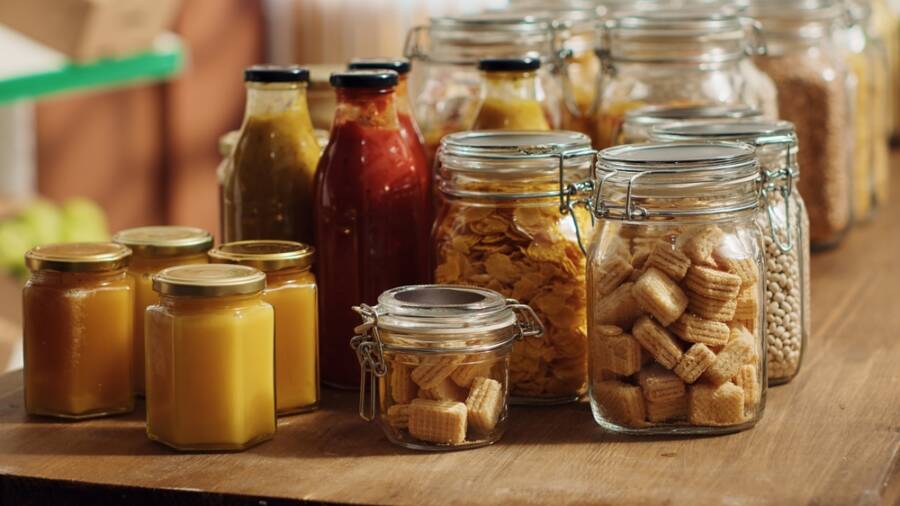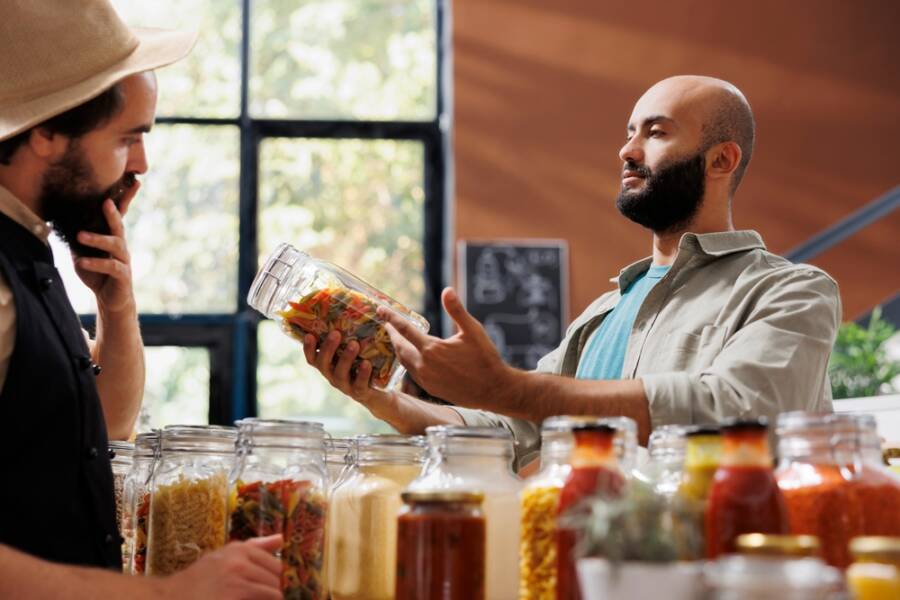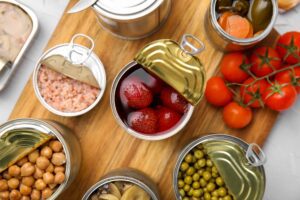We’re all quite familiar with the benefits of a well-stocked pantry. It’s fairly essential for menu planning organization, and it also helps maintain a healthy diet rich in real foods. On top of that, it helps you save money by letting you stock up when food items are on sale.
However, if food isn’t stored as it should and is allowed to spoil, what’s the point of buying in bulk? That’s one of the reasons why it’s so important to know how to store your pantry food for maximum shelf life.
To make things even worse, waste in the average North American kitchen is at an all-time high. The numbers are quite shocking, actually. Too much food is being thrown away these days. Is it coming from your kitchen?
If that’s the case, you might be eating well, but you are definitely not spending less. In this series, I thought we could take a look at how to keep all those tasty groceries as fresh and well-stored as we can, and therefore, keep our money in our pockets.

Contamination equals cash lost
Food spoilage takes place when items are poor quality or even damaged when bought, when they’re plain old, or when they’re not stored properly, which allows for damage to take place. What’s exactly damaging our food?
Well, it can be either heat, cold, air, light, moisture, smells, or critters. Any of these factors can easily ruin our hard-earned food, and they can all be prevented. Now, after doing a thorough research on the matter, my pantry is quite a museum, if I can say so myself.
Ingredients are rarely left in their initial packaging, and I take great care to store them accordingly. I’m not that interested in losing a bag of organic steel-cut oats to ants or any other type of foreign invaders.
How do you exactly store pantry food for maximum shelf life?
Believe it or not, we don’t think plastic bags or cardboard boxes are quite as effective for long-term food storage as it is generally believed. Dry ingredients, for instance, need to live in a hard container like glass, hard plastic, or metal.
We prefer using a combination of these three. We, for instance, are big fans of “containerization”. Sounds familiar? No? Okay, let me break it down for you: it’s a technique based on using containers and organizing your kitchen as simple and aesthetically pleasing as it gets.
Containers help organize because they easily group items and help combat the sprawl that might happen behind closed doors and drawers alike. Besides, confining these items to only one place, makes clean-up less of a chore, especially since the container can easily be removed and washed under. They can also combat many of these dangerous elements to our food like moisture, air, and even critters.
Glass jars
The majority of my dry pantry items are mainly stored in glass jars, and so are many other fridge and freezer items, for that matter. They are our preferred container, and here’s why:
- they are very affordable;
- they are reusable and recyclable;
- they display contents so you can find anything in a glance;
- they are airtight;
- they have a rustic, and country look that will definitely suit your kitchen.
Here’s a list of foods you can store in glass jars: grains, legumes, seeds, nuts, dried herbs, dried mushrooms, dried fruits, cereals, flour, pasta, and many others.
Tupperware
It’s quite hard to beat Tupperware when it comes to having durable and airtight pantry storage. They’re not as cheap as basic glass jars, but let’s be honest, how many jars offer a lifetime guarantee? Tupperware is great because you stuff anything in, but especially items that get easily scattered over the pantry, like crackers, granola bars, dried fruits, and such.
Large Tupperware containers also allow for an orderly pantry, so that any furry intruder will get bored and hungry. The larger hard plastic containers also help make cleaning a lot easier and keep the pantry sprawl to a minimum.
Here’s a list of foods you can store in Tupperware: flour, sugars, granola bars, chocolate, crackers, bread crumbs, ground nuts, and many others.
Tins
Whether large or small, square or round, tins are perfect for containing small and easily scattered items such as dried yeast packages and tea bags. Tins also offer a dry, dark, and airtight space, and one that I prefer storing some foreign ingredients in for maximum shelf life.
The only drawback to tins is that you can’t see inside, and items could potentially go unnoticed for some time if you are not careful.
Here’s a list of foods you can store in tins: coffee, dried chilies and spices, seaweed, rice noodles, rice papers, tea, yeast, gelatin, and many other things.
Pantry items to store in your freezer
Plenty of foods should be kept in the freezer to extend storage life, especially during humid months: flours, nuts, spices (especially ground ones), some grains like wheat germs and flax, and seeds, whether it’s sunflower, sesame, or other type of seeds.
Ground spices also retain their condition and quality best when they are stored in an airtight container in the freezer. On a similar note, nuts and flours stay fresher for longer when they’re kept cold.

Stocking the homestead pantry
The homestead pantry should definitely include what would generally be used (and more) and anything that might be needed if the situation allows it. Our food storage pantry includes a wide variety of foods that can put together plenty of meals.
The pantry should be 100% functional, above all. Stock foods that you want to eat, and eat the foods that you stock. That’s the rule. We highly suggest planning your long-term food storage ahead. Sit down and make time to create a master list of everything that’s needed to put your frequently-cooked meals together. This can include anything, from salt to salmon. You can use this master list to stock your pantry.
Fruits and vegetables
Fruits and vegetables are important in any well-stocked pantry. These foods can be easily stored in various different ways. They might be laid up as canned or even dehydrated foods. You can ferment, pickle, or simply store these foods as they arrive in your house.
In my pantry, I keep a lot of green beans, sweet corn, greens, summer squash, a couple of varieties of tomato sauce, tomato paste, juice, peppers, winter squash, onions, sweet potatoes, peas, carrots, pears, blackberries, peaches, apples, and applesauce.
Also, a proper storage pantry will store food in different ways. The primary way in which you can store food should be tallied into your yearly amounts and should also be stocked diligently. Home canning, if considered, should be stored in a convenient way.
For instance, we have plenty of quarts of home-canned apples in our pantry, but we also have quite a few dehydrated ones. If you’re lucky like us, you can store some in the fall to use them fresh.
Pantry math
You will also need to store a small portion of these foods. Simple math can be used to get a ballpark figure. For instance, if your family uses two cans of sweet corn every week, then you might have to multiply 2 by 52 to get an estimate of how much to store.
That would equal 104 pints of corn for a year. You can also do ten percent of the number to store. Ten percent of 104 would be 10.4. Naturally, you can’t have .4 of a pint, so you might as well add 10 extra pints of corn to the 104. This is just to make sure you have something extra.
Another important rule is to eat the oldest foods in your pantry first. You can plan your meals around the pantry. This is generally how we manage to determine the amounts we want to store, especially since we’ve done this for quite a while.
If you are brand new to food preservation, you need to pay attention to what you generally eat so you can start planning your garden and establish how much to store in the long-term food pantry. I personally don’t recommend freezing these foods, especially since electricity can be quite unreliable.
You can either dehydrate or store the foods fresh. With my potatoes, for instance, I prefer having around 400 to 450 pounds stored fresh in the pantry. Basic foods should be the only ones categorized for food storage.
Any other homemade convenience foods (also known as meals-in-a-jar) should be, as much as possible, counted separately and carefully replaced when needed. Again, this is meant to keep the homestead pantry comfortably stocked, so it will efficiently provide our needs abundantly when the time calls for it.
Pickles, relishes, jams, and jellies
Everyone has treats and sweets at home. Your pantry should be well-stocked with plenty of flavors of homemade jams, jellies, and even pickles. These will give your meals a flair. You can easily stock your shelves with your favorites in any amount you prefer.
I decided to make a special place in mine, lined with jars of blackberry jelly, orange marmalade, blueberry jam, strawberry jam, and many other things. We also have tons of sweet pickles, bread, butter pickles, and pickle relish to eat in case we ever feel like having any of these.
You can also keep a couple of jars of pickled peppers to eat on homemade pizza. All these items aren’t seen as too hardcore when it comes to food storage. They mainly serve as a means of livening up your meals with sugar, spice, and some vinegar.
Meats
For some time now, meat has generally been frozen as the main storage method for most households. I don’t like to freeze meat or anything else, for that matter. A freezer might suffer from a mechanical failure, the power might go out, or the food itself might get freezer-burned.
I am pretty sure that some folks are now gagging at the mere thought of canned meat. We don’t think it’s gross at all. Even a picky eater wouldn’t tell the difference between a canned and a frozen one. We still recommend leaving some types of meat alone, like steaks, beef roasts, and ground beef in the freezer.
But if you’re looking for long-term food storage, canned meat is quite convenient. It takes the work right out of cooking too many meals, and I really find meat an easy food to can. It allows your meals to come together rapidly without the actual hassle of defrosting and cooking a package of meat.
Grains, flour, pasta, and legumes
If you’re anything like me, you probably eat a lot of grain products on a daily basis. You might have oatmeal for breakfast, a sandwich for lunch, and a hot roll to go with your chili. You might even have popcorn for a snack later on.
All these meals involve some type of grain or legume. A good long-term food storage pantry automatically features grains, flour, and beans in abundance. These foods are generally very inexpensive to buy and are also extremely nutritious.
A proper long-term food storage pantry will display white flour, whole wheat flour, wheat berries, popcorn, cornmeal, rolled oats, rice, pasta, and a rich variety of dry beans. The amount you decide to store might differ, according to your household’s needs.
I personally like to keep around 300 pounds of white flour, 20 pounds of whole wheat flour, and 100 pounds of wheat berries well-stashed in my beautiful pantry.
As you can imagine, the bulk of these foods will last forever. The oily germ in whole wheat flour and cornmeal will also turn the food rancid after a year of storage. That’s exactly why it’s so important to store an abundance of wheat berries and popcorn in your pantry.
Both of these store well and can be easily ground into flour or meal when you need them. A grain mill is also important to own to process your long-term food storage. I personally store these items in food-grade pockets on the pantry floor.
You can easily get these buckets for free from department stores. They are wonderful storage containers! I also store some of these items in half-gallon jars on the pantry shelf for easier access. If the item was bought in bulk packaging, I prefer emptying it into a clean bucket and then sealing the lid.
But if it was bought in common retail packaging, I store it in the bag and then in a sealed bucket. The storage’s main goal is to keep the food in and the vermin, bugs, and moisture out. Good storage is fairly important for a great pantry.
Dairy and eggs
In case of long-term emergency situations, milk, butter, cheese, and eggs might not be as available as you think. A good long-term food storage pantry will help you tackle such situations. We did a little bit of research and for now, there’s no proven safe method of dehydrating dairy and eggs at home. But, I’ve heard through the grapevine that you can easily eat some foods, like milk, butter, and cheese.
But in case you’re not interested in trying this option, dry milk is fairly essential. Without a reliable source of dairy products, plenty of meals wouldn’t be possible. I’ve seen plenty of survival sites mentioning outrageous amounts of dry milk, and nothing is actually wrong with larger quantities.
One of the easiest and most frugal ways to get dry milk is to get it in large boxes from stores such as Walmart, and then repackage it for long-term storage in glass jars. It should be able to stay this way for many years, especially if you use an oxygen absorber.
You can also buy it in cans from emergency preparedness retailers. It’s close to impossible to find dehydrated eggs, butter, or cheese in the neighborhood grocery stores. I would personally advise you to store around two #10 cans of butter and eggs per person in your own household.
Cheese powder should also be stocked based on how much you eat. It’s not as important to most recipes, as we see it more as a treat. You might also want to consider stocking powdered sour cream and buttermilk in decent quantities for your household.
Sugar and sweeteners
Sugar needs to be packaged in the same way as other dry goods. I prefer storing 100 pounds of white sugar, 15 pounds of brown sugar, 10 pounds of powdered sugar, 2 gallons of honey, 1 gallon of molasses, and 2 gallons of pancake syrup.
You will definitely need these babies for cooking, later on. The sugar should also be packaged into food-grade buckets, and if you can, just leave it in the original packaging. As for honey and molasses, we recommend using glass jars on the pantry shelf. You can keep a smaller jar upstairs for daily use, and then you can add depending on how fast you consume it.
If you found this article useful, we also recommend checking: 9 Reasons Why Frugal People Pay EVERYTHING in Cash















One Response
Just show me pictures of things to put in jars! That’s the quick and dirty way to get your point across. Show don’t tell.